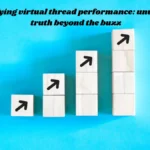In today’s fast-paced digital world, organizations are constantly seeking ways to improve efficiency and adaptability. Event-Driven Process Orchestration: A Practitioner’s ViewPoint that aligns business processes with real-time events. This methodology empowers businesses to respond swiftly to changes in their environment, ensuring they remain competitive.
As a practitioner in this field, I’ve witnessed firsthand how EDPO can revolutionize operations. By harnessing the power of event-driven architecture, companies can streamline workflows and enhance collaboration across departments. Join me as we explore the nuances of EDPO and uncover its principles, benefits, challenges, and practical applications for modern enterprises. Let’s dive into the dynamic realm of event-driven process orchestration together!
Event-Driven Process Orchestration: A Practitioner’s ViewPoint
Event-Driven Process Orchestration (EDPO) fundamentally changes how businesses operate. It allows organizations to coordinate processes based on real-time events, leading to greater efficiency and agility. This adaptability is crucial in today’s ever-evolving landscape.
From a practitioner’s perspective, the implementation of EDPO requires a shift in mindset. Organizations must embrace an event-driven architecture that prioritizes responsiveness over traditional linear models. This can foster innovation across teams.
In practice, EDPO creates interconnected ecosystems where data flows seamlessly between systems and departments. The result is enhanced collaboration and improved decision-making capabilities, ultimately driving better business outcomes without the delays often associated with conventional processes.
Introduction to Event-Driven Process Orchestration (EDPO)
Event-Driven Process Orchestration: A Practitioner’s ViewPoint is a modern approach that enhances business processes through real-time event management. It allows organizations to respond swiftly to changes in their environment, improving operational efficiency and agility.
At its core, EDPO focuses on triggering actions based on events rather than traditional batch processing methods. This means that as soon as an event occurs—be it a customer action or system alert—the appropriate response can be initiated without delay.
By leveraging technologies such as microservices and APIs, EDPO integrates various components within an organization seamlessly. This orchestration ensures that systems work together harmoniously, leading to streamlined workflows and better alignment with business goals.
Read More: Demystifying Virtual Thread Performance: Unveiling the Truth Beyond the Buzz
Understanding Event-Driven Architecture (EDA)
Event-Driven Architecture (EDA) is a software design paradigm that revolves around the production, detection, consumption, and reaction to events. An event signifies a change in state or an occurrence within a system. By focusing on these events rather than fixed processes, EDA allows for more flexible and responsive applications.
In EDA, components communicate asynchronously through event brokers or message queues. This decoupling enhances scalability and promotes agility across systems. As each component operates independently, it can evolve without disrupting others.
The architecture excels in dynamic environments where real-time data processing is crucial. Industries like finance and e-commerce leverage EDA to improve responsiveness and customer experience by reacting promptly to user actions and system changes.
Principles of Event-Driven Process Orchestration
Event-Driven Process Orchestration (EDPO) revolves around several core principles that enhance efficiency and responsiveness. It emphasizes decoupling components, allowing systems to operate independently while communicating through events. This flexibility enables rapid adaptations to changing business needs.
Real-time processing is crucial in EDPO. Systems react instantly to incoming events, facilitating timely decision-making and improved operational agility. Quick responses often lead to enhanced customer experiences.
Scalability plays a pivotal role in EDPO’s design. As businesses grow or face fluctuating demands, the orchestration framework can efficiently manage increased event loads without compromising performance or reliability. Emphasizing these principles helps organizations harness the full potential of their processes and technologies effectively.
Read More: Wellhealthorganic.com : Morning Coffee Tips with No Side Effect
Benefits of Event-Driven Process Orchestration
Event-Driven Process Orchestration: A Practitioner’s ViewPoint offers numerous advantages for organizations looking to enhance their operational efficiency. One significant benefit is the improved responsiveness to changes in real-time. Businesses can react promptly to events, ensuring they stay competitive in a fast-paced environment.
Another key advantage is increased flexibility. EDPO allows organizations to easily adapt processes without major disruptions. This adaptability enables teams to innovate and optimize workflows quickly.
Moreover, EDPO promotes better collaboration across departments by breaking down silos. Teams can work together seamlessly as they share information through event-driven communication, leading to enhanced productivity and streamlined operations throughout the organization.
Challenges in Implementing Event-Driven Process Orchestration
Implementing Event-Driven Process Orchestration (EDPO) comes with its share of challenges. One significant hurdle is the complexity of integrating various systems and services. Organizations often rely on legacy technologies that may not seamlessly work in an event-driven environment.
Another challenge is ensuring data consistency across multiple events and processes. As events trigger actions, maintaining accuracy becomes critical to avoid errors or service disruptions.
Organizations face a skills gap in understanding EDPO frameworks. Many teams lack experience with event-driven architecture principles, making it difficult to fully leverage the benefits of this approach without proper training or resources.
Implementation Strategies for Event-Driven Process Orchestration: A Practitioner’s ViewPoint
To successfully implement Event-Driven Process Orchestration (EDPO), organizations should begin by defining clear objectives. Understanding the business goals helps in designing an effective architecture that aligns with organizational needs.
Next, it’s crucial to select the right tools and technologies that support event-driven systems. Popular platforms like Apache Kafka or RabbitMQ can facilitate seamless messaging between different services.
Fostering a culture of collaboration among teams is essential for EDPO success. Encourage cross-functional communication to ensure everyone understands their roles within the orchestration process. This collaborative spirit helps streamline workflows and enhances adaptability in dynamic environments.
Real-World Applications of Event-Driven Process Orchestration
Event-Driven Process Orchestration (EDPO) finds widespread application across various industries. In e-commerce, it enhances customer experiences by triggering personalized recommendations based on user behavior in real-time. This responsiveness helps drive sales and improve customer satisfaction.
In the finance sector, EDPO is used for fraud detection. By monitoring transactions through event streams, organizations can quickly identify anomalies and respond promptly to potential threats. This agility is crucial in protecting sensitive financial data.
Healthcare also benefits from EDPO by streamlining patient care processes. Events such as lab results or appointment bookings can automatically trigger notifications or updates to healthcare providers, ensuring timely responses that enhance patient outcomes and operational efficiency.
Read More: How Ontpress .com Revolutionizes Online Publishing
Conclusion
Event-Driven Process Orchestration: A Practitioner’s ViewPoint represents a significant shift in how businesses manage workflows and respond to events. By leveraging the principles of Event-Driven Architecture (EDA), organizations can enhance their agility, streamline operations, and improve customer experiences.
Despite its advantages, implementing EDPO is not without challenges. It requires careful planning, robust infrastructure, and a cultural shift within teams. However, with the right strategies and tools in place, these hurdles can be overcome.
Real-world applications of EDPO demonstrate its effectiveness across various industries—from finance to healthcare—showing that it is not just a theoretical concept but a practical approach for enhancing operational efficiency.
As more organizations recognize the value of real-time responsiveness, embracing event-driven processes will become increasingly essential for staying competitive in today’s fast-paced digital landscape.



